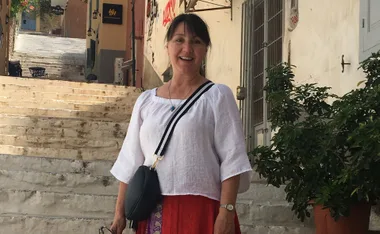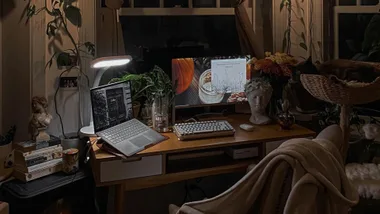After an unsettling encounter on safari with an amorous antelope, Mike Dolan explores the national parks and cultural beacons of the Indian state of Gujarat.
We haven’t even been formally introduced and yet Mr Boo Boo seems determined to rub his large mottled lips against mine. Because he outweighs me by at least 220kg, it’s impossible to push him away. Helplessly trapped with my back to a thorn bush, I’m rescued by a loud thump and a high-pitched shout as Mr Boo Boo reels around to face his aggressor: a skinny little boy, armed with a stout stick.
Later, my host, Micky Desai, owner of Blackbuck Lodge, tells me that Mr Boo Boo was paying me a compliment. “He favours very few,” murmurs Mr Desai over the phone. “He meant no harm, sir. Put it down to high spirits,” he adds soothingly, as if reading a passage from a Jane Austen novel.
Mr Desai is talking to me from Ahmedabad, the Gujarati state capital, a five-hour drive north of the lodge. Covering 40 hectares of savannah, the lodge borders Velavadar Blackbuck National Park, where 2300 blackbuck antelope, 700 nilgai and a small population of grey wolves roam.
A blackbuck stag with its spiral antlers at Velavadar National Park. Photograph by Mike Dolan.

Velvavadar is one of India’s lesser known national parks and a convenient stop-over when visiting several of Gujarat’s safari destinations, including Sasan Gir National Park, home to the world’s last wild Asiatic lions.
It’s advisable to hire a reliable car and good driver on a road tour in India. Our tour of Gujarat began with a flight from Mumbai to Diu, a former Portuguese colony on the Arabian Sea, and then a two-hour drive to Sasan Gir, followed by a seven-hour drive to Blackbuck Lodge, via Palitana, the great mountain-top temple complex of the Jains. From Blackbuck Lodge, it’s a four-hour drive north to Ahmedabad.

Back at Blackbuck Lodge, I’m sitting in the dappled shade on the terrace of one of Mr Desai’s villas, marveling at the blackbuck, with their impressive spiraling horns, grazing among stands of hip-high golden grass and thorn trees.
Mr Boo Boo is lying down in the grass nearby. Happily, cordial relations between myself and the nilgai have been established, and every time I arrive at the villa, he greets me with a lick on the hand. All the animals, tame and wild, are free to wander between the national park and lodge, where an enticing man-made lake is ringed by 14 spacious deluxe villas and restaurant, which serves excellent Gujarati food. Safari drives into the park occur twice daily and if you’re lucky you may see grey wolves, jackals and jungle cats, as well as the blackbuck and nilgai.
A young Asiatic male lion at Sasan Gir National Park. Photograph by Mike Dolan.

Those in search of big cats should head for the Sasan Gir National Park and spend between two to three days in search of lion. The best place to stay is the Gateway Hotel Gir Forest that borders the national park of the same name. Sasan Gir is home to more than 400 Asiatic lions and 311 Indian leopards. The Gateway hotel has a magnificent location overlooking the Hiran River and the forested mountain slopes of the adjoining park.
Three-hour safari drives leave the hotel at 6am and 3.30pm every day and even though I was told lion sightings were more common in the early morning, I saw a pride of four during the late afternoon on my first outing.
The Gateway is owned by Taj Hotels, India’s most pukka portfolio of properties, that owns many of the sumptuous palace hotels of India and is, without doubt, the best available place to stay at Sasan Gir. The river rooms all have spacious balconies facing the river, the food is excellent, the grounds immaculate and there’s also a spa with affordable treatments.
Diu is often compared with Goa, 800km south. Both are former Portuguese colonies with magnificent forts and white cathedrals. But Diu is no tropical idyll; those seeking swaying palm trees and glorious beaches should head for Goa.
That said, Diu is a fascinating island port and the only place in the region where you can legally buy alcohol. Gujarat is a dry state, almost three times the size of Tasmania, and only international visitors can buy a beer after applying for a licence — a laborious process involving India’s notorious bureaucracy.

Between Sasan Gir and Blackbuck Lodge is Palitana, the holiest pilgrimage destination for the Jains. It stands like a beacon on a high ridge above a vast plain. More than 860 gilded temples embellish the mountain top, accessible after a two-kilometre, 600-metre ascent up 4000 steps.
The return walk takes a fit person around three hours and that includes 30-minutes’ exploration at the top. Or you can hire a dholi, a material seat slung between two bamboo poles, carried by two sure-footed men.
The mosque at the Sarkjej Roza in Ahmedabad. Photograph by Mike Dolan.


After Palitana and Blackbuck lodge, Ahmedabad is a three-hour drive from Blackbuck Lodge. A bustling metropolis with superb pre-Mughal architecture, and mosques, the state capital is also famous for its stepwells, intricately carved sandstone galleries that lead to pools of fresh water deep underground. One of the most famous is the Adalaj Stepwell in a village within the suburbs of the city. On a hot day, there’s nothing cooler than milling around at the bottom of a stepwell.
Gandhi’s Ashram on the Sabarmati River, Ahmedabad. Photograph by Mike Dolan.

Lastly, there’s the Gandhi Ashram on the holy Sabarmati River, where the great man lived for 12 years, a peaceful oasis that attracts hundreds of thousands of pilgrims each year. Gandhi’s house, his bedroom and living room, with his spinning wheel, are lovingly preserved.
From Gandhi and the simple life of the ashram, it seems strange to enter the House of MG , once the palatial home of the fabulously wealthy Mangaldas Girdhardas family, and now an historical hotel. Great philanthropists, the family built much of the commercial infra-structure of Gujarat, and this rambling palace provides a fascinating insight on how the other half once lived.









.jpg?resize=380%2C285)
-(4)-(1).png?resize=380%2C285)

